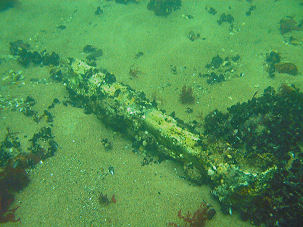Stolteraa Wreck: Lost British Bomber on Baltic Sea near Warnemünde
- Roger Blum

- 4. März 2022
- 2 Min. Lesezeit
Just off from Stolteraa, a small stretch of coast on the Baltic Sea near Warnemünde, lies in a depth of 6 m the wreck of an English bomber. The remains of the plane are located 1.5 nm west of the lighthouse in the area. Theoretically, the spot can be reached by swimming from land. To get there and back, however, it is approximately 1,400 m, a distance not to be underestimated. Therefore it’s preferable to dive by boat.
Once you reach the wreck buoy and dive towards the beach (150 degrees), you will come across a few pieces of scrap metal and find a seagrass meadow at 5 m to your right. There's not much left of the plane itself. The airplane has come apart and is scattered in small parts over the area of half a football field.
From the barrel to the west you should be able to find parts of the chassis with the aircrafts rims and tires. There are small bits of the plane dispersed around the entire area. You can still see the frame of the wings and with a little luck, you’ll also find a propeller, which lies a little further towards the land.
However, special care should be taken when diving to the wreck because from time to time, ammunition is flushed out of passing gunships and into the water. The ammunition recovery service has already cleared the area several times, but the stocks in the water haven’t necessarily been exhausted yet.
Facts to Lancaster-Bomber: The Avro 683 "Lancaster" bomber is the most famous heavy bomber type of the Royal Air Force in the Second World War. On 9 January 1941, the prototype's maiden flight was performed. The mass production started at the beginning of 1942. The bomber could carry a maximum of 6.35 tons of bombs. Altogether Avro produced 3,425 Lancaster Mk.I, 33 were converted to the Lancaster B Mk I (Special) with enlarged bomb bay for the 9,070 kg bomb "Grand Slam". Lancasters were used, beside night attacks on German cities, also on special bomb missions, as for instance with the sinking of the German battleship Tirpitz with 5443 kg heavy bombs (Tallboy). In total, the Lancaster bombers flew over 156,000 missions in World War II and dropped 608,612 tons of bombs.

















Kommentare